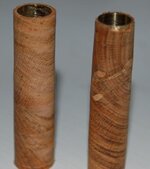Sandy H.
Member
In the attached picture, the right blank has a small blow out near the top. I'm thinking the correct way to salvage it is to turn the last 1/8" or so on that end down to the brass tube, drill a 25/64" hole in a walnut segment and epoxy it in place, then turn it back to finished size.
My 2 questions are:
1: Would this be your recommended fix? On large wood projects, its common to glue sawdust in place, but I think this wouldn't work on something this size/level of detail.
2: Would thick CA (or another adhesive) be preferred to 5 minute epoxy?
For reference, I think the blowout occurred due to the orientation of the blank grain, as well as my still poorly developed skew technique. I used 5 minute epoxy to bond the coarsely sanded brass tube to the Apricot wood.
Any other thoughts or comments are appreciated.
Sandy.
My 2 questions are:
1: Would this be your recommended fix? On large wood projects, its common to glue sawdust in place, but I think this wouldn't work on something this size/level of detail.
2: Would thick CA (or another adhesive) be preferred to 5 minute epoxy?
For reference, I think the blowout occurred due to the orientation of the blank grain, as well as my still poorly developed skew technique. I used 5 minute epoxy to bond the coarsely sanded brass tube to the Apricot wood.
Any other thoughts or comments are appreciated.
Sandy.

